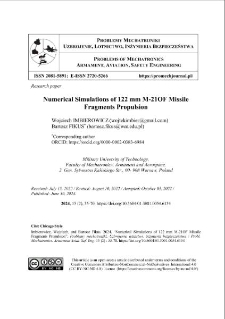Nasza Biblioteka Cyfrowa udostępnia 1 868 obiektów cyfrowych
Obiekt
Tytuł: Numerical Simulations of 122 mm M-21OF Missile Fragments Propulsion ; Numerical Simulations of 122 mm M-21OF Missile Fragments Propulsion
Tytuł odmienny:
Badania numeryczne procesu napędzania odłamków 122 mm rakietowego pocisku M-21OF ; Badania numeryczne procesu napędzania odłamków 122 mm rakietowego pocisku M-21OF
Współtwórca:
Abstrakt:
This paper presents numerical simulations of 122 mm M-21OF rocket fragments propulsion. A simplified geometry of the rocket was constructed and analysed with two main numerical FE approaches: a mesh-based lagrangian-eulerian FSI method and a coupled meshless SPH–lagrangian approach. The resulting fragment velocities were compared with those obtained from an analytical approach (Gurney formula). The shell fragmentation process was also successfully depicted. Both numerical approaches differed from the analytical velocity results to a comparable degree. Considering that the Gurney energy of a high-explosive is obtained from cylinder expansion tests, results obtained with the Gurney method can be treated as a reference point and validation method for natural fragmentation warhead models.
;
This paper presents numerical simulations of 122 mm M-21OF rocket fragments propulsion. A simplified geometry of the rocket was constructed and analysed with two main numerical FE approaches: a mesh-based lagrangian-eulerian FSI method and a coupled meshless SPH–lagrangian approach. The resulting fragment velocities were compared with those obtained from an analytical approach (Gurney formula). The shell fragmentation process was also successfully depicted. Both numerical approaches differed from the analytical velocity results to a comparable degree. Considering that the Gurney energy of a high-explosive is obtained from cylinder expansion tests, results obtained with the Gurney method can be treated as a reference point and validation method for natural fragmentation warhead models.
Miejsce wydania:
Warszawa
;
Warszawa
Wydawca:
Wojskowa Akademia Techniczna ; Wojskowa Akademia Techniczna
Data utworzenia:
Data złożenia:
Data akceptacji:
Data wydania:
Rozmiar:
Identyfikator:
oai:ribes-88.man.poznan.pl:2705
Sygnatura:
doi:10.5604/01.3001.0054.6154 ; doi:10.5604/01.3001.0054.6154
ISSN elektroniczny:
ISSN drukowany:
Język:
Licencja:
kliknij tutaj, żeby przejść ; kliknij tutaj, żeby przejść
Właściciel praw:
Wojskowa Akademia Techniczna ; Wojskowa Akademia Techniczna
Strona początkowa:
Strona końcowa:
Tom:
Czasopismo:
Słowa kluczowe:
mechanical engineering, terminal ballistics, numerical simulation, initial fragment velocity, LS-DYNA ; mechanical engineering, terminal ballistics, numerical simulation, initial fragment velocity, LS-DYNA
Kolekcje, do których przypisany jest obiekt:
Data ostatniej modyfikacji:
16 paź 2025
Data dodania obiektu:
16 paź 2025
Liczba wyświetleń treści obiektu:
0
Wszystkie dostępne wersje tego obiektu:
https://ribes-88.man.poznan.pl/publication/3042
Wyświetl opis w formacie RDF:
Wyświetl opis w formacie OAI-PMH:
| Nazwa wydania | Data |
|---|---|
| Numerical Simulations of 122 mm M-21OF Missile Fragments Propulsion | 16 paź 2025 |

